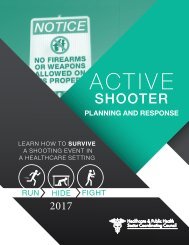ACTIVE
2017_Active_Shooter_Planning_and_Response_in_a_Healthcare_Setting
2017_Active_Shooter_Planning_and_Response_in_a_Healthcare_Setting
You also want an ePaper? Increase the reach of your titles
YUMPU automatically turns print PDFs into web optimized ePapers that Google loves.
people in need. It is critically important to share this information with law enforcement and<br />
other first responders before an emergency occurs. Law enforcement agencies have secure<br />
websites where this information is stored for many businesses, public venues, and other<br />
locations. All of these can be provided to first responders and viewed in drills, exercises, and<br />
walk-throughs.<br />
Technology and tools with the same information (e.g., a portable USB drive that is compatible<br />
with computers used by first responders) should be maintained in secured locations in the<br />
facility from which healthcare facility officials can immediately provide it to responding officials<br />
or from which first responders can directly access it. The locations of these materials at the<br />
healthcare facility should be known by and accessible to a number of individuals to ensure<br />
ready access in an emergency. Every healthcare facility should have more than one individual<br />
charged with meeting first responders to provide them with the healthcare facility site<br />
assessment, the healthcare facility EOP, and any other details about healthcare facility safety<br />
and the facility. All parties should know who these key contacts are.<br />
Exercises<br />
Most healthcare facilities practice evacuation drills for fires and protective measures for natural<br />
disasters, but far fewer healthcare facilities practice for active shooter situations. To be<br />
prepared for an active shooter incident, healthcare facilities should train their staff, in what to<br />
expect and how to react.<br />
Good planning involves conducting drills which involve first responders and facility security<br />
teams, and includes the role of sworn local law enforcement officers employed or stationed in<br />
the emergency department or other areas of the facility. Exercises with these valuable partners<br />
are one of the most effective and efficient ways to ensure everyone knows not only her or his<br />
role(s) but also the role(s) of others at the scene. These exercises should include walks through<br />
the healthcare facility and other campus buildings to allow law enforcement officials to provide<br />
input on shelter sites as well as familiarize first responders with the campus, including shelter<br />
locations, evacuation routes, and locations where patients who may be unable to evacuate,<br />
such as the operating room, critical care units, nurseries, and pediatric units.<br />
Each person carries a three-fold responsibility.<br />
First: Learn the signs of a potentially volatile situation and ways to prevent an incident.<br />
Second: Learn the best steps for survival when faced with an active shooter situation.<br />
Third: Be prepared to work with law enforcement during the response.<br />
Page | 17



